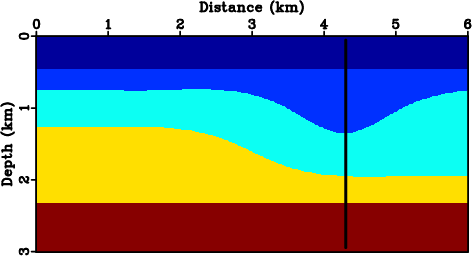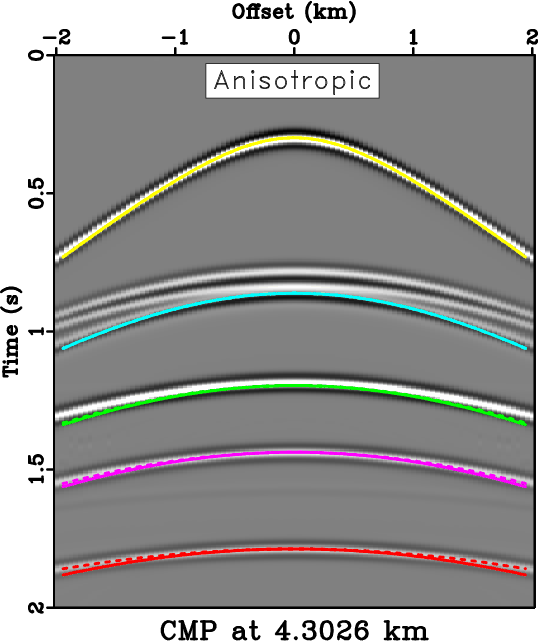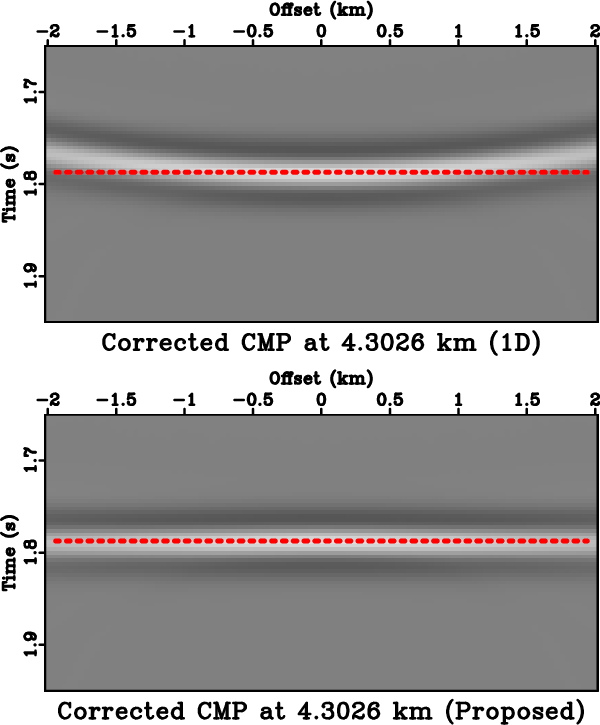|
|
|
|
Effects of lateral heterogeneity on time-domain processing parameters |
Next: Layered isotropic model with Up: Reflection traveltime in multilayer Previous: Reflection traveltime in multilayer
We consider first a layered anisotropic model in Figure 4 with parameters shown in Table 1. The model contains both a synclinal structure and a variable dipping layer that can lead to noticeable effects from lateral heterogeneity. Each layer in this model is homogeneous, hence only the effects from curved interfaces (derivatives of  ) are important. We note that the depths of the top three reflectors are smaller than 2
) are important. We note that the depths of the top three reflectors are smaller than 2  , which is the spread length of offset in this experiment. Therefore, the offset-to-depth ratio is greater than unity and additional effects of moveout nonhyperbolicity caused by anisotropy are important (Tsvankin, 2012). As a result, possible improvement from modifying the NMO velocity proposed under the hyperbolic traveltime assumption in this study may not be as prominent for these three reflectors.
, which is the spread length of offset in this experiment. Therefore, the offset-to-depth ratio is greater than unity and additional effects of moveout nonhyperbolicity caused by anisotropy are important (Tsvankin, 2012). As a result, possible improvement from modifying the NMO velocity proposed under the hyperbolic traveltime assumption in this study may not be as prominent for these three reflectors.

|
|---|
|
modcol
Figure 4. A test subsurface model with a synclinal structure and a variable dipping interface. The solid black line indicates the location of the extracted CMP gather. |
|
|
| Anisotropic parameters |  |
 |
 |
 |
 |
 |
 |
 |
 |
 |
| Layer 1 | 9.0 | 9.0 | 3.0 | 3.0 | 1.0 | 1.0 | 3.0 | 1.732 | 0.0 | 0.0 |
| Layer 2 | 12.72 | 10.23 | 5.55 | 2.57 | 1.13 | 1.14 | 3.20 | 1.60 | 0.121 | 0.046 |
| Layer 3 | 14.47 | 9.57 | 4.51 | 2.28 | 1.58 | 1.68 | 3.09 | 1.51 | 0.256 | -0.050 |
| Layer 4 | 13.0 | 13.0 | 5.0 | 4.0 | 1.0 | 1.0 | 3.61 | 2.0 | 0.0 | 0.0 |
| Layer 5 | 22.05 | 14.89 | 5.34 | 4.93 | 1.34 | 1.423 | 3.86 | 2.22 | 0.240 | 0.012 |
 and
and  are anelliptic parameters in the Muir-Dellinger scheme convenient for uses in group velocity approximations (Sripanich and Fomel, 2015).
are anelliptic parameters in the Muir-Dellinger scheme convenient for uses in group velocity approximations (Sripanich and Fomel, 2015).
Figure 5 shows the CMP gather at 4.3  that compares moveout approximations with NMO velocity computed based on the 1-D stratified medium assumption and from the proposed formula (equation 11). For the bottom two reflectors with the offset-to-depth ratio smaller than unity, we can observe a better performance from the latter with improved flatness of the corrected gather.
that compares moveout approximations with NMO velocity computed based on the 1-D stratified medium assumption and from the proposed formula (equation 11). For the bottom two reflectors with the offset-to-depth ratio smaller than unity, we can observe a better performance from the latter with improved flatness of the corrected gather.


|
|---|
|
hypercompareaniso2,warpedcompareaniso2
Figure 5. (a) An example CMP gather from the layered anisotropic model at 4.3  . Note the multiple reflection events above the second moveout curve that are caused by the syncline. The solid lines correspond to regular moveout predictions based on the assumption of 1-D stratified model, whereas the dashed lines correspond to those from the proposed framework that takes into account the effects from heterogeneity. (b) Flattened reflections from the bottom interface using the NMO velocity with 1-D assumption (top) and the proposed framework (bottom). We can clearly observe improved flatness from using the proposed framework. . Note the multiple reflection events above the second moveout curve that are caused by the syncline. The solid lines correspond to regular moveout predictions based on the assumption of 1-D stratified model, whereas the dashed lines correspond to those from the proposed framework that takes into account the effects from heterogeneity. (b) Flattened reflections from the bottom interface using the NMO velocity with 1-D assumption (top) and the proposed framework (bottom). We can clearly observe improved flatness from using the proposed framework.
|
|
|